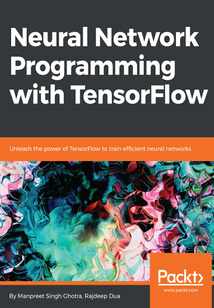舉報 

會員
Neural Network Programming with TensorFlow
最新章節:
TensorBoard
Thisbookismeantfordeveloperswithastatisticalbackgroundwhowanttoworkwithneuralnetworks.ThoughwewillbeusingTensorFlowastheunderlyinglibraryforneuralnetworks,bookcanbeusedasagenericresourcetobridgethegapbetweenthemathandtheimplementationofdeeplearning.IfyouhavesomeunderstandingofTensorflowandPythonandwanttolearnwhathappensatalevellowerthantheplainAPIsyntax,thisbookisforyou.
目錄(200章)
倒序
- coverpage
- Title Page
- Copyright
- Neural Network Programming with TensorFlow
- Credits
- About the Authors
- About the Reviewer
- www.PacktPub.com
- Why subscribe?
- Customer Feedback
- Preface
- What this book covers
- What you need for this book
- Who this book is for
- Conventions
- Reader feedback
- Customer support
- Downloading the example code
- Downloading the color images of this book
- Errata
- Piracy
- Questions
- Maths for Neural Networks
- Understanding linear algebra
- Environment setup
- Setting up the Python environment in Pycharm
- Linear algebra structures
- Scalars vectors and matrices
- Tensors
- Operations
- Vectors
- Matrices
- Matrix multiplication
- Trace operator
- Matrix transpose
- Matrix diagonals
- Identity matrix
- Inverse matrix
- Solving linear equations
- Singular value decomposition
- Eigenvalue decomposition
- Principal Component Analysis
- Calculus
- Gradient
- Hessian
- Determinant
- Optimization
- Optimizers
- Summary
- Deep Feedforward Networks
- Defining feedforward networks
- Understanding backpropagation
- Implementing feedforward networks with TensorFlow
- Analyzing the Iris dataset
- Code execution
- Implementing feedforward networks with images
- Analyzing the effect of activation functions on the feedforward networks accuracy
- Summary
- Optimization for Neural Networks
- What is optimization?
- Types of optimizers
- Gradient descent
- Different variants of gradient descent
- Algorithms to optimize gradient descent
- Which optimizer to choose
- Optimization with an example
- Summary
- Convolutional Neural Networks
- An overview and the intuition of CNN
- Single Conv Layer Computation
- CNN in TensorFlow
- Image loading in TensorFlow
- Convolution operations
- Convolution on an image
- Strides
- Pooling
- Max pool
- Example code
- Average pool
- Image classification with convolutional networks
- Defining a tensor for input images and the first convolution layer
- Input tensor
- First convolution layer
- Second convolution layer
- Third convolution layer
- Flatten the layer
- Fully connected layers
- Defining cost and optimizer
- Optimizer
- First epoch
- Plotting filters and their effects on an image
- Summary
- Recurrent Neural Networks
- Introduction to RNNs
- RNN implementation
- Computational graph
- RNN implementation with TensorFlow
- Computational graph
- Introduction to long short term memory networks
- Life cycle of LSTM
- LSTM implementation
- Computational graph
- Sentiment analysis
- Word embeddings
- Sentiment analysis with an RNN
- Computational graph
- Summary
- Generative Models
- Generative models
- Discriminative versus generative models
- Types of generative models
- Autoencoders
- GAN
- Sequence models
- GANs
- GAN with an example
- Types of GANs
- Vanilla GAN
- Conditional GAN
- Info GAN
- Wasserstein GAN
- Coupled GAN
- Summary
- Deep Belief Networking
- Understanding deep belief networks
- DBN implementation
- Class initialization
- RBM class
- Pretraining the DBN
- Model training
- Predicting the label
- Finding the accuracy of the model
- DBN implementation for the MNIST dataset
- Loading the dataset
- Input parameters for a DBN with 256-Neuron RBM layers
- Output for a DBN with 256-neuron RBN layers
- Effect of the number of neurons in an RBM layer in a DBN
- An RBM layer with 512 neurons
- An RBM layer with 128 neurons
- Comparing the accuracy metrics
- DBNs with two RBM layers
- Classifying the NotMNIST dataset with a DBN
- Summary
- Autoencoders
- Autoencoder algorithms
- Under-complete autoencoders
- Dataset
- Basic autoencoders
- Autoencoder initialization
- AutoEncoder class
- Basic autoencoders with MNIST data
- Basic autoencoder plot of weights
- Basic autoencoder recreated images plot
- Basic autoencoder full code listing
- Basic autoencoder summary
- Additive Gaussian Noise autoencoder
- Autoencoder class
- Additive Gaussian Autoencoder with the MNIST dataset
- Training the model
- Plotting the weights
- Plotting the reconstructed images
- Additive Gaussian autoencoder full code listing
- Comparing basic encoder costs with the Additive Gaussian Noise autoencoder
- Additive Gaussian Noise autoencoder summary
- Sparse autoencoder
- KL divergence
- KL divergence in TensorFlow
- Cost of a sparse autoencoder based on KL Divergence
- Complete code listing of the sparse autoencoder
- Sparse autoencoder on MNIST data
- Comparing the Sparse encoder with the Additive Gaussian Noise encoder
- Summary
- Research in Neural Networks
- Avoiding overfitting in neural networks
- Problem statement
- Solution
- Results
- Large-scale video processing with neural networks
- Resolution improvements
- Feature histogram baselines
- Quantitative results
- Named entity recognition using a twisted neural network
- Example of a named entity recognition
- Defining Twinet
- Results
- Bidirectional RNNs
- BRNN on TIMIT dataset
- Summary
- Getting started with TensorFlow
- Environment setup
- TensorFlow comparison with Numpy
- Computational graph
- Graph
- Session objects
- Variables
- Scope
- Data input
- Placeholders and feed dictionaries
- Auto differentiation
- TensorBoard 更新時間:2021-07-02 15:17:44
推薦閱讀
- 漫話大數據
- 計算機組成原理與接口技術:基于MIPS架構實驗教程(第2版)
- Python絕技:運用Python成為頂級數據工程師
- 數據分析實戰:基于EXCEL和SPSS系列工具的實踐
- 數據庫基礎與應用:Access 2010
- 數據之巔:數據的本質與未來
- Learning Spring Boot
- 工業大數據分析算法實戰
- 區塊鏈通俗讀本
- 深入理解InfluxDB:時序數據庫詳解與實踐
- 中文版Access 2007實例與操作
- 數據挖掘競賽實戰:方法與案例
- openGauss數據庫核心技術
- 算法設計與分析
- 算力經濟:從超級計算到云計算
- 成功之路:ORACLE 11g學習筆記
- 推薦系統全鏈路設計:原理解讀與業務實踐
- 實用數據結構基礎(第四版)
- MATLAB基礎及其應用教程
- 商業銀行數據庫管理實踐
- 零基礎學SQL
- 短文本數據理解
- Data Mesh權威指南
- 數據庫技術與應用新概念教程(第二版)
- Power BI數據分析與數據可視化(微課版)
- iPhone Location Aware Apps by Example -Beginners Guide
- 低代碼極速物聯網開發指南:基于阿里云IoT Studio快速構建物聯網項目
- 數據庫系統及應用(第2版)
- 數據架構之道:數據模型設計與管控
- Oracle J.D.Edwards技術與應用:基礎篇

